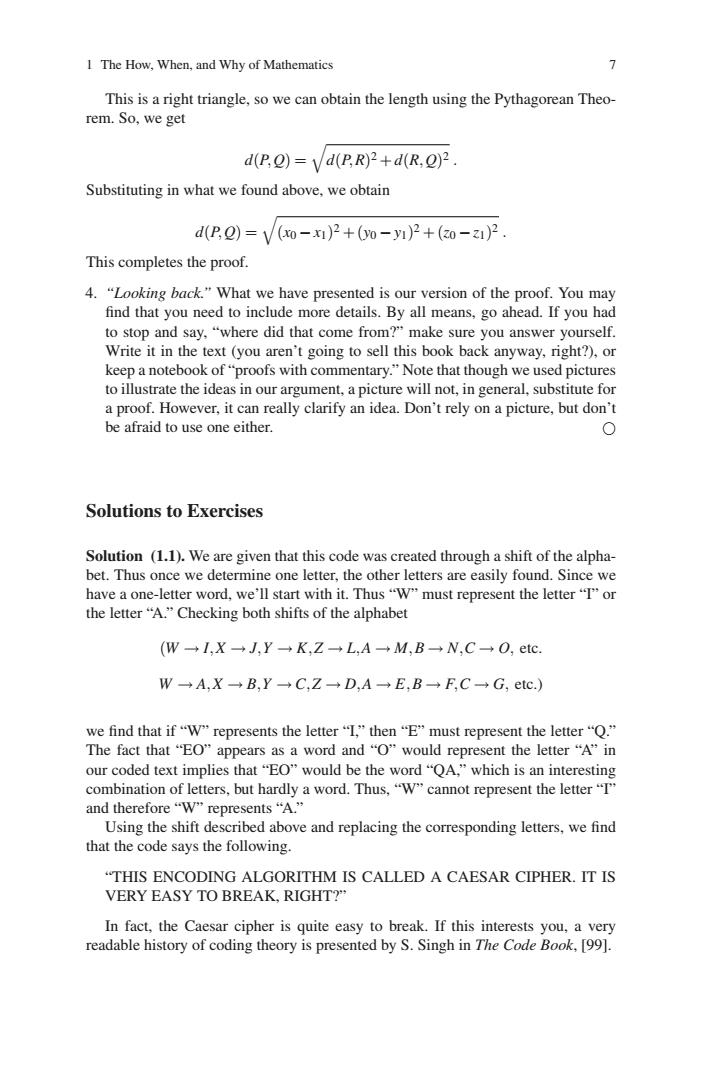正在加载图片...

I The How,When,and Why of Mathematics 7 This is a right triangle,so we can obtain the length using the Pythagorean Theo- rem.So,we get d(P,Q)=Vd(P.R)2+d(R.Q)2 Substituting in what we found above,we obtain d(P0)=V(o-x)2+0o-y)2+(0-z1)2. This completes the proof. 4."Looking back."What we have presented is our version of the proof.You may find that you need to include more details.By all means,go ahead.If you had to stop and say,"where did that come from?"make sure you answer yourself. Write it in the text(you aren't going to sell this book back anyway,right?),or keep a notebook of"proofs with commentary.Note that though we used pictures to illustrate the ideas in our argument,a picture will not,in general,substitute for a proof.However,it can really clarify an idea.Don't rely on a picture,but don't be afraid to use one either. 0 Solutions to Exercises Solution (1.1).We are given that this code was created through a shift of the alpha- bet.Thus once we determine one letter,the other letters are easily found.Since we have a one-letter word,we'll start with it.Thus"W"must represent the letter"I"or the letter"A."Checking both shifts of the alphabet (W→I,X→J,Y→K,Z→L,A+M,B→N,C→O,etc W→A,X→B,Y→C,Z→D,A→E,B→F,C→G,et.) we find that if“W”represents the letter"I,”then"E”must represent the letter“Q.” The fact that"EO"appears as a word and"O"would represent the letter "A"in our coded text implies that“EO”would be the word“QA,”which is an interesting combination of letters,but hardly a word.Thus,"W"cannot represent the letter"T" and therefore“W'represents“A.” Using the shift described above and replacing the corresponding letters,we find that the code says the following. "THIS ENCODING ALGORITHM IS CALLED A CAESAR CIPHER.IT IS VERY EASY TO BREAK,RIGHT?" In fact,the Caesar cipher is quite easy to break.If this interests you,a very readable history of coding theory is presented by S.Singh in The Code Book,[99].1 The How, When, and Why of Mathematics 7 This is a right triangle, so we can obtain the length using the Pythagorean Theorem. So, we get d(P,Q) = q d(P,R)2 +d(R,Q)2 . Substituting in what we found above, we obtain d(P,Q) = q (x0 −x1)2 + (y0 −y1)2 + (z0 −z1)2 . This completes the proof. 4. “Looking back.” What we have presented is our version of the proof. You may find that you need to include more details. By all means, go ahead. If you had to stop and say, “where did that come from?” make sure you answer yourself. Write it in the text (you aren’t going to sell this book back anyway, right?), or keep a notebook of “proofs with commentary.” Note that though we used pictures to illustrate the ideas in our argument, a picture will not, in general, substitute for a proof. However, it can really clarify an idea. Don’t rely on a picture, but don’t be afraid to use one either. Solutions to Exercises Solution (1.1). We are given that this code was created through a shift of the alphabet. Thus once we determine one letter, the other letters are easily found. Since we have a one-letter word, we’ll start with it. Thus “W” must represent the letter “I” or the letter “A.” Checking both shifts of the alphabet (W → I,X → J,Y → K,Z → L,A → M,B → N,C → O, etc. W → A,X → B,Y → C,Z → D,A → E,B → F,C → G, etc.) we find that if “W” represents the letter “I,” then “E” must represent the letter “Q.” The fact that “EO” appears as a word and “O” would represent the letter “A” in our coded text implies that “EO” would be the word “QA,” which is an interesting combination of letters, but hardly a word. Thus, “W” cannot represent the letter “I” and therefore “W” represents “A.” Using the shift described above and replacing the corresponding letters, we find that the code says the following. “THIS ENCODING ALGORITHM IS CALLED A CAESAR CIPHER. IT IS VERY EASY TO BREAK, RIGHT?” In fact, the Caesar cipher is quite easy to break. If this interests you, a very readable history of coding theory is presented by S. Singh in The Code Book, [99]